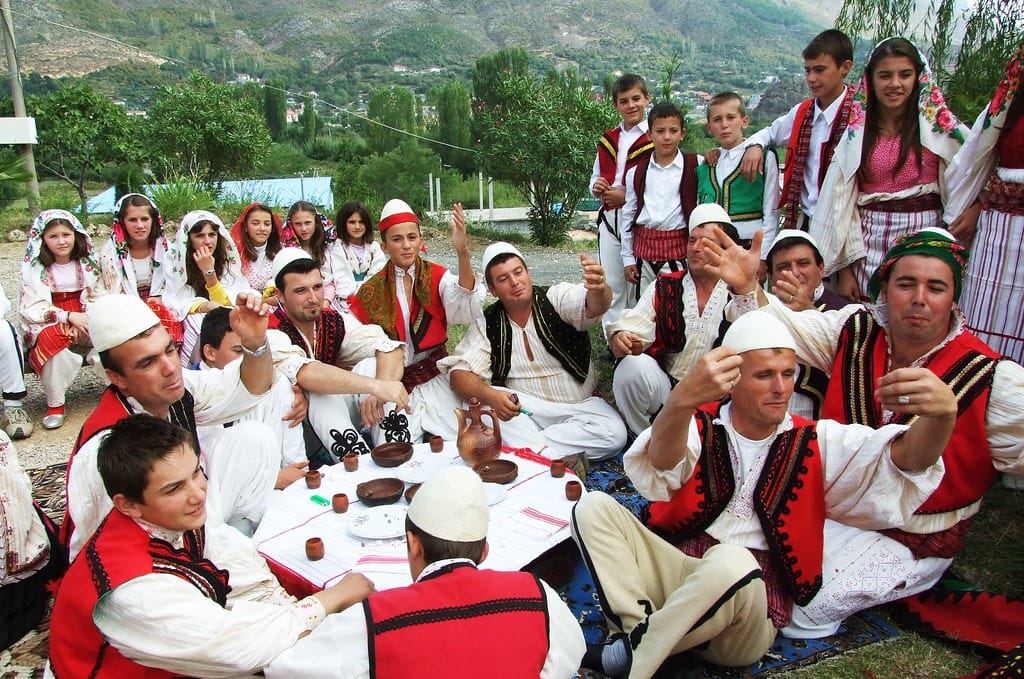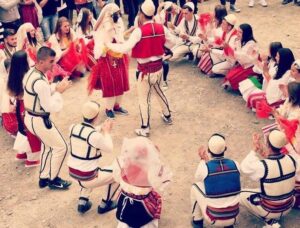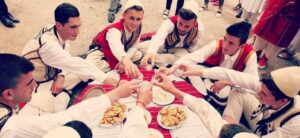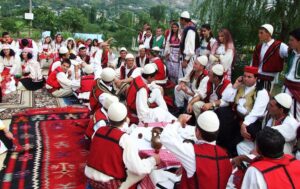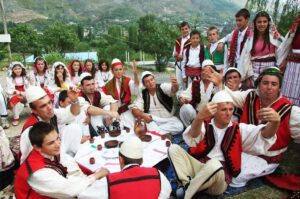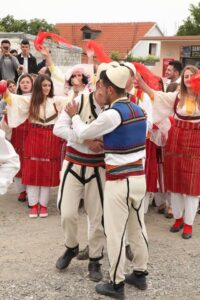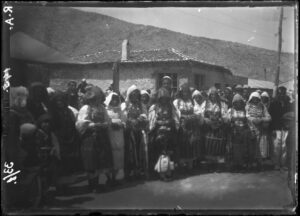Zadrima wedding takes place following pertinent traditions and rituals, as described below:
The banns of marriage (public announcement of marriage by the priest) 2 weeks before the wedding ceremony in the church.
The kinsmen discuss about the wedding arrangements a few days in advance (Wednesday evening), deciding for the messengers to invite the guests on the father’s and mother’s side.
On Saturday morning, the wedding gifts are sent out to the bride’s house and the dowry is received.
On Saturday evening, the wedding party unfolds with songs in a cordial festive atmosphere.
On the wedding Sunday, the relatives and wedding invite come together and get ready to fetch the bride, with the oldest relative coming first, followed by the uncle and all the people as arranged at the groom’s house by the family head.
Once the groom’s brothers’ band arrives at the bride’s house, the people closest to her come in front of them lining up to welcome them. Meanwhile, the pre-determined people treat the wedding invites with tobacco and raki and afterwards, they are invited to take their pre-designated seats and get settled.
People remain in their seats while sharing traditional blessings and words of honor.
Wedding guests and invites are not allowed to sing until the bride rides the horse (wedding car).
The bride’s family cordially shows the wedding guests out, gives away the bride and then the bride rides the horse along with xheveri as her male representative (a boy not older than 12 years old).
The bride’s father says “Përhajr” (“Happy married life”) and addresses to the groom’s father: “O mik, fillo kangën tesh” / “Gjer dje ka qenë e Zotit dhe e jemja, sot asht e Zotit dhe e jotja”, (“My dear friend, start singing now” / “Until yesterday she belonged to God and me, today she belongs to God and you”).
The bride’s father-in-law treats the wedding guests with tobacco and raki and they set off with widely known, indirect songs.
The bride’s arrival at the groom’s house is greeted with the women and men singing altogether. She gets off the horse and xheveri rides the horse. The bride gets in and the people sit back around the table on their seats and continue singing (wedding, humorous songs) and dancing.
While the wedding is coming to its end, women step out and sing the song “2 dele 300 pare, (filani) del në valle” (“2 sheep 300 money, (a certain person) starts dancing”) inviting out all the men around the table.
Once everyone stands up, dancing flares up. When it is over, the wedding guests, relatives and friends congratulate the young couple with heartfelt greetings and so the Zadrima wedding is over.
Wedding guests as well as kinfolk and friends are dressed in traditional Zadrima folk costumes.
Zadrima costumes are among the most beautiful in our country, overwhelmed with bright and optimistic colors – red, yellow and green. The bridal harkate (pure silk yarn) shirts, made with great finesse, white and yellow silk, with bird embroideries and matched silky rhombic figures, show too much fantasy and art. The buttoned jelek-s (bodice), colorful aprons, the silver and gold brooches, the golden necklace and crown, rings, quasi transparent and masterfully crafted headdresses, express the creative spirit and finesse of Zadrima artisan women and girls. Men’s costumes are more serious, with white çakçirë (white narrow-legged felt trousers) lightly embroidered at the cuffs and pockets, with a shorter belt than women’s, with cherry-colored jelek or white xhurdi (jacket), with abounding black fringes and stitched seams and white felt cap. Yet, Zadrima songs and folk dances are the most beautiful of all, distinguished for their varied, gentle, optimistic and relaxing melodies, which are the cherry on the cake of Zadrima wedding party.

